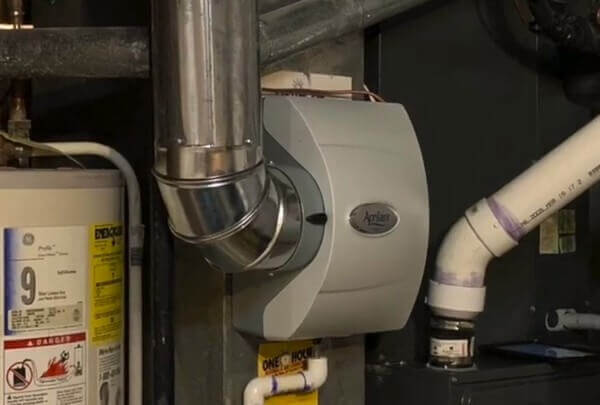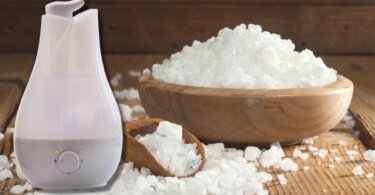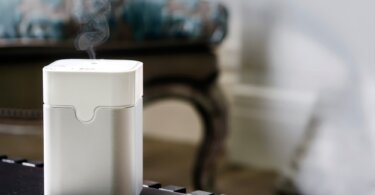
Have you been feeling that the air inside your home is too dry and just plain uncomfortable?
The indoor air quality and dryness issues are closely related to the humidity levels around you. That’s why homeowners install a central humidifier system or whole-house humidifier to keep every room humidified, so the air is more comfortable to breathe.
Bypass and power humidifiers can do wonders when it comes to combating issues caused by low humidity. In this article, we’ll discuss the differences between the bypass and fan-power humidifiers so you can make a well-informed choice.
What is a Bypass Humidifier and How Does It Work
A bypass humidifier is the least expensive unit and easily adapts to both hard and soft water sources. It does not have its own fan, so you have to fix it directly to your central HVAC system. The unit makes use of the HVAC blower motor to push humidified air through the air handler.
Bypass humidifiers consist of a water reservoir, a cabinet, a rotating drum with a motor, and a float unit.
You have to connect the system to the furnace, so the warm air is forced into the cabinet. Then, the air flows over the rotating drum, and the motor rotates the drum over the water reservoir as the float unit controls the rotation speed.
This process generates moist air that will pass through the HVAC channels and vent out into your home. The moisture humidifies the air around your space, and the humidistat monitors the humidity levels.
What is a Power Humidifier and How Does It Work
A power humidifier has the same basic elements of a bypass unit with one extra feature — a fan. The fan-powered humidifier works as a standalone unit without the need for a furnace fan.
It directly controls the moisture levels in the air and distributes the air throughout the home all by itself.
The fan gives the power humidifier an edge over its bypass counterparts. It forces the warm air across the float at a higher speed, which results in more humidity using lesser energy. You can monitor and adjust the moisture levels using the humidistat.
The mechanics of the system makes it ideal for large homes with multiple rooms that need moisture. Due to their higher efficiency, fan-powered humidifiers are now gaining popularity as compared to bypass humidifiers.
Read: Top rated humidifiers for 1000 sq ft
The Differences Between Bypass and Fan-Powered Humidifiers
Here are four major differences between bypass humidifiers and power humidifiers that will help you understand them better.
Cost
The cost of the humidifier will largely depend on the model you select. However, the fan-powered humidifiers typically cost more than their bypass counterparts.
Moreover, the operation and maintenance costs of fan-powered humidifiers are also higher. Since these systems use built-in fans, they relatively consume more electricity.
On the other hand, a bypass system requires a bypass duct installation, so you will have to install new ductwork to connect your humidifier with the furnace.
The good thing is, once you have installed the system, it takes significantly less maintenance and adapts to both soft and hard water sources. The only care it needs is annual filter changes and drain tube cleaning.
Efficiency
Bypass humidifiers are less efficient because the moist air has to pass through the furnace fans for distribution, which results in humidity loss. Moreover, the units use more water to prevent mineral buildup in the water panel.
While bypass humidifiers depend on your heating and cooling system’s blower motor, power humidifiers work as an independent unit. That means they humidify the air and distribute it directly around the home. They prevent water loss, and you can use them with or without a furnace running.
As these systems produce more humidity, they deliver better results in larger spaces.
Noise
Bypass humidifiers are quieter than fan-powered ones because they do not have a fan running inside them. You can reduce the louder sound of your power humidifier using soundproofing techniques such as insulation.
Installation
Many bypass units can be mounted on to a wall and connected to air ducts for easy installation. They have low installation costs, and you can easily upgrade them into a power humidifier when the need occurs. The only problem is, they take up more space due to the bypass duct.
On the other hand, power humidifiers cover less space because they don’t require a ductwork system. They also have low installation costs and can be installed in homes without basements or HVAC systems located in a smaller space.
Conclusion
All in all, if you want to use your humidifier when heating is off or don’t have enough space to install bypass ductwork, a power humidifier is the best option for you. Alternatively, if you want a quieter unit with low installation and maintenance costs, you should go for a bypass humidifier.




